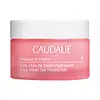What's inside
What's inside
 Key Ingredients
Key Ingredients

 Benefits
Benefits

 Concerns
Concerns

 Ingredients Side-by-side
Ingredients Side-by-side

Water
Skin ConditioningGlycerin
HumectantVitis Vinifera Fruit Water
Skin ConditioningIsostearyl Isostearate
EmollientOctyldodecyl Myristate
EmollientSqualane
EmollientMicrocrystalline Cellulose
AbsorbentCaprylic/Capric Triglyceride
MaskingBenzyl Alcohol
PerfumingXanthan Gum
EmulsifyingCarbomer
Emulsion StabilisingCellulose Gum
Emulsion StabilisingCaprylyl Glycol
EmollientVitis Vinifera Juice
AntioxidantSodium Hyaluronate
HumectantSodium Hydroxide
BufferingAloe Barbadensis Leaf Juice
Skin ConditioningHelianthus Annuus Seed Oil
EmollientTocopherol
AntioxidantCitric Acid
BufferingDehydroacetic Acid
PreservativeSodium Phytate
Sodium Carboxymethyl Beta-Glucan
CleansingSodium Benzoate
MaskingPotassium Sorbate
PreservativeParfum
MaskingWater, Glycerin, Vitis Vinifera Fruit Water, Isostearyl Isostearate, Octyldodecyl Myristate, Squalane, Microcrystalline Cellulose, Caprylic/Capric Triglyceride, Benzyl Alcohol, Xanthan Gum, Carbomer, Cellulose Gum, Caprylyl Glycol, Vitis Vinifera Juice, Sodium Hyaluronate, Sodium Hydroxide, Aloe Barbadensis Leaf Juice, Helianthus Annuus Seed Oil, Tocopherol, Citric Acid, Dehydroacetic Acid, Sodium Phytate, Sodium Carboxymethyl Beta-Glucan, Sodium Benzoate, Potassium Sorbate, Parfum
Water
Skin ConditioningParaffinum Liquidum
EmollientGlycerin
HumectantPetrolatum
EmollientStearic Acid
CleansingGlyceryl Stearate
EmollientSesamum Indicum Seed Oil
EmollientUrea
BufferingLanolin Alcohol
EmollientTriethanolamine
BufferingHordeum Vulgare Extract
EmollientCucumis Sativus Fruit Extract
EmollientHelianthus Annuus Seedcake
AbrasivePropylene Glycol Dicaprate
EmollientSodium Hyaluronate
HumectantButylene Glycol
HumectantPentylene Glycol
Skin ConditioningTrisodium EDTA
Phenoxyethanol
PreservativeCI 15985
Cosmetic ColorantCI 19140
Cosmetic ColorantCI 17200
Cosmetic ColorantWater, Paraffinum Liquidum, Glycerin, Petrolatum, Stearic Acid, Glyceryl Stearate, Sesamum Indicum Seed Oil, Urea, Lanolin Alcohol, Triethanolamine, Hordeum Vulgare Extract, Cucumis Sativus Fruit Extract, Helianthus Annuus Seedcake, Propylene Glycol Dicaprate, Sodium Hyaluronate, Butylene Glycol, Pentylene Glycol, Trisodium EDTA, Phenoxyethanol, CI 15985, CI 19140, CI 17200
 Reviews
Reviews

Ingredients Explained
These ingredients are found in both products.
Ingredients higher up in an ingredient list are typically present in a larger amount.
Glycerin is already naturally found in your skin. It helps moisturize and protect your skin.
A study from 2016 found glycerin to be more effective as a humectant than AHAs and hyaluronic acid.
As a humectant, it helps the skin stay hydrated by pulling moisture to your skin. The low molecular weight of glycerin allows it to pull moisture into the deeper layers of your skin.
Hydrated skin improves your skin barrier; Your skin barrier helps protect against irritants and bacteria.
Glycerin has also been found to have antimicrobial and antiviral properties. Due to these properties, glycerin is often used in wound and burn treatments.
In cosmetics, glycerin is usually derived from plants such as soybean or palm. However, it can also be sourced from animals, such as tallow or animal fat.
This ingredient is organic, colorless, odorless, and non-toxic.
Glycerin is the name for this ingredient in American English. British English uses Glycerol/Glycerine.
Learn more about GlycerinSodium Hyaluronate is hyaluronic acid's salt form. It is commonly derived from the sodium salt of hyaluronic acid.
Like hyaluronic acid, it is great at holding water and acts as a humectant. This makes it a great skin hydrating ingredient.
Sodium Hyaluronate is naturally occurring in our bodies and is mostly found in eye fluid and joints.
These are some other common types of Hyaluronic Acid:
Learn more about Sodium HyaluronateWater. It's the most common cosmetic ingredient of all. You'll usually see it at the top of ingredient lists, meaning that it makes up the largest part of the product.
So why is it so popular? Water most often acts as a solvent - this means that it helps dissolve other ingredients into the formulation.
You'll also recognize water as that liquid we all need to stay alive. If you see this, drink a glass of water. Stay hydrated!
Learn more about Water